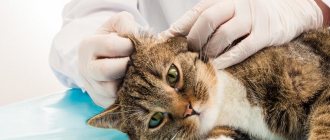4857Pavel
A pathology that causes obstruction of urinary outflow is called renal hydronephrosis. In cats and dogs, this disease is not uncommon. With the disease, the renal pelvis expands, the tissue atrophies, the functioning of the organ gradually deteriorates and, as a result, the animal experiences severe renal failure. The disease can be either congenital or acquired. Since the kidneys are a paired organ, the disease can affect one or two kidneys at once.
With a congenital anomaly, there is underdevelopment of the ureteric tract and pathological expansion of the renal pelvis. Congenital factors cause further development of the disease in cats.
© shutterstock
If the disease is acquired, then usually the following factors become its causes::
- urolithiasis of the kidneys;
- damage and injury to the kidneys and bladder;
- tumors, cysts, dropsy;
- prostate atrophy;
- adhesions;
- surgical interventions, infection.
Main reasons
According to veterinarians, the main source of enlargement of the renal pelvis is considered to be inflammatory processes that negatively affect the structure of the urinary organ.
Hydronephrosis can be unilateral or bilateral, in which one or both kidneys of a cat are damaged. The second form of the disease is more difficult to treat because it leads to more serious structural changes. The development of hydronephrosis is influenced by the following factors:
- mechanical damage that occurs during road accidents, bites of other animals, falls or bruises;
- formation of stones, which is associated with blocking of the ureter by large uroliths;
- malignant or benign tumors in the urinary system that disrupt the outflow of urine;
- abnormal development of the cat’s internal organs;
- insufficient fluid intake or poor quality;
- problems with excess weight;
- complications that arise after sterilization of a pet or other surgical intervention.
How does it manifest?
As the disease progresses, the urinary organs work less and less well.
Kidney disease in cats has different symptoms depending on the stage of hydronephrosis. The main stages of the disease and pathological changes are presented in the table:
| Stage | Features of the flow |
| I | The expansion is fixed only from the side of the renal pelvis |
| Pyeelectasis with slight deviation of urinary function is diagnosed | |
| II | The calyxes of the kidneys also expand |
| The cat suffers from a decrease in the thickness of the parenchyma, which reduces its functionality | |
| The efficiency of the internal organ drops to 40% | |
| III | Severe atrophy of kidney tissue |
| Kidney function is completely lost |
At the initial stages, owners are not always able to identify hydronephrosis in a timely manner and consult a doctor. Symptoms tend to occur in later stages, when the disease is more difficult to treat. The following pathological signs are characteristic of the disorder in cats:
With this pathology, the animal may have an elevated body temperature.
- enlarged abdominal cavity;
- increase in pet's body temperature;
- refusal of food;
- bloody spots in the urine;
- delayed urination.
Hydronephrosis
- home
- Articles
- Publications of specialists
- Veterinary
- Hydronephrosis
Hydronephrosis
- kidney disease, characterized by expansion of the pyelocaliceal system, atrophy of the renal parenchyma and progressive deterioration of all basic functions of the kidney as a result of impaired outflow of urine from the kidney, as well as impaired blood circulation.
In modern practice, there are two types of hydronephrosis: primary and secondary. Primary or congenital hydronephrosis develops due to congenital obstructions in the area of the ureteropelvic segment (ureteric ectopia, stenosis, ureteral atresia). Secondary or acquired hydronephrosis is usually a consequence of any disease (urolithiasis, tumor of the kidney, pelvis, ureter, bladder, traumatic injury to the bladder, neoplasms of the abdominal and pelvic cavities, prostatic hypertrophy, etc.) Hydronephrosis can be either unilateral, in which one of the kidneys is affected, and bilateral, in which both kidneys are affected. The presence of an obstruction at the level of the ureterovesical segment leads to the development of unilateral hydronephrosis, and with obstruction in the area of the bladder neck or urethra, bilateral hydronephrosis occurs. There is a classification of obstacles that arise in various parts of the urinary tract and lead to the development of hydronephrosis: • Obstacles located in the urethra, urethra, and bladder (uroliths, tumors, clots and hematomas after injuries, etc.) • Obstacles in or outside the ureter lumen (tumors, uroliths, ureteral diverticula, neoplasms of the abdominal cavity or retroperitoneal space, hematomas due to trauma, adhesions after surgery) •Impairments in the position of the ureter (twists or kinks, congenital atresia of the ureter, congenital stenosis or due to a long-term inflammatory process, ectopia) •Obstacles in the lumen of the pelvis – nephrolites, neoplasms, blood clots after injuries and hematomas. Hydronephrosis is divided into three stages:
Stage 1 - dilation of only the pelvis (pyelectasia) with minor impairment of kidney function.
Stage 2 - expansion of the pelvis and a decrease in the thickness of the kidney parenchyma and a significant impairment of its function. Stage 3 - sharp atrophy of the kidney parenchyma and its transformation into a thin-walled sac. With the development of hydronephrosis, secondary microflora may join, which provokes the development of secondary inflammatory kidney diseases (secondary pyelonephritis). When the internal structure of the kidney changes, its hemodynamics are also disrupted. Increased intraparenchymal pressure and swelling of the organ leads to compression of the intrarenal vessels and an increase in the speed of blood flow and blood pressure in them. Impaired blood circulation in the capillaries of the cortical and medulla layers of the kidney leads to oxygen starvation of the kidney and disruption of tissue metabolism, which in turn contributes to atrophic changes in the renal cortex. So how can you recognize that your pet is developing such a serious illness? Hydronephrosis often develops asymptomatically in the early stages, especially in animals. Unfortunately, clinical symptoms are nonspecific and are most often accompanied by apathy, lethargy, possibly elevated body temperature, refusal to feed, possibly increased thirst, a specific odor from the mouth and vomiting (with the development of severe uremia). The longer hydronephrosis develops, the worse the animal feels. Intoxication with one's own metabolic products increases. Acute postrenal renal failure develops. Often the owner thinks that we are talking about poisoning or pathology of the gastrointestinal tract (vomiting, refusal to feed), and if the diagnosis is not accurate enough, a completely different pathology is treated. In this case, the role of an erroneous diagnosis can be fatal for the animal, since with the development of hydronephrosis, the clock can count. The risk group includes animals
that • have recently been injured (fall from a high floor, car injury, beating, bites by other animals), • animals that have recently undergone surgery, including sterilization, hysterectomy (development of adhesive disease), • animals having a history of urolithiasis or suspected of urolithiasis, • young animals that suddenly feel unwell. Symptoms may also include: an increase in the abdomen on one side in small kittens and puppies (congenital hydronephrosis), the presence of blood in the urine or difficulty urinating, a decrease in the volume of urine when the animal urinates, pain in the lumbar region and a hunched back, an increase in the volume of the abdomen (with acute retention urine in case of urolithiasis), frequent urge to urinate. That is why the doctors at our center advise: as soon as you notice a deterioration in your pet’s condition or a change in its behavior, you should immediately consult a doctor. Moreover, this should be done immediately if your animal is injured or falls from a high floor. Only in a veterinary clinic, with the appropriate equipment, is it possible to make a reliable diagnosis and provide qualified veterinary care to your pet. First of all, the animal is examined, palpated and a detailed history is collected, then blood is taken, if possible, a urine test is collected, then additional diagnostics are carried out: ultrasound, radiography, possibly contrast excretory urography are required. In the early stages of hydronephrosis development, excretory urography is more sensitive and gives an idea of the secretory function of the kidneys. Ultrasound examination is more reliable in moderate and severe forms of hydronephrosis (stages 2-3). After a complete examination of the animal and receipt of laboratory results, the doctor makes predictions and selects treatment methods. Treatment can be either conservative (at the initial stage of development of the pathology, depending on its cause), or surgical if the kidney is severely changed structurally and impaired, or its function is absent. If bilateral hydronephrosis develops due to ureteral or urethral obstruction, the animal may quickly die from acute postrenal renal failure before significant atrophy of the renal parenchyma develops. At the same time, ultrasound may reveal less significant structural changes in the kidneys. In the case of unilateral ureteral obstruction, compensatory processes in the unaffected kidney lead to its hypertrophy and hydronephrosis of the affected kidney. That is why it is very important for cat owners (especially those with a history of urolithiasis) to pay attention to the urination of their pets; any urinary retention for more than 12 hours is suspicious; urinary retention for more than a day is an acute condition in which the animal should be immediately taken to the clinic ! When acute urinary retention is diagnosed due to blockage of the urethra by uroliths, surgical intervention is usually performed - dilating urethrostomy. If there are large uroliths in the bladder, they are removed promptly through a bladder incision. When unilateral hydronephrosis stage 3 is detected, as a rule, the affected kidney is removed provided that the structure and function of the second kidney is normal. If a tumor of the bladder or ureter is detected, treatment depends on the results of histological or cytological examination. In any case, the treatment method and the decision on surgical intervention are made individually in accordance with the condition of the animal at the time of admission to the clinic. In conclusion, I would like to add that the health of our beloved pets is in our hands and the more attentive we are to them, the better their standard of living. Love for our animals also includes caring for their health.
01 June 2010
31497
Health to you and your pets!
© 2020 Team "ZOOVET" We are always happy to help you! 24-hour consultation: +7 Make an appointment [email protected]
Return to list
Diagnostic procedures
To identify hydronephrosis, you need to contact a veterinary clinic, since it is almost impossible to determine kidney disease on your own, especially in the early stages. The veterinarian conducts a visual examination of the pet and collects a detailed medical history. It is possible to establish the causes of the pathological process and the degree of hydronephrosis using the following diagnostic procedures:
- ultrasound diagnostics of the kidneys;
- radiography;
- contrast excretory urographic examination;
- laboratory urine test.
Necessary treatment
According to veterinarian I. G. Sharabrin, treatment of hydronephrosis in cats of the bilateral type is not effective, while the unilateral type of the disease can be cured with early diagnosis.
Most often, this pathology requires surgical treatment.
As a rule, the main therapeutic measure is surgery, in which the affected paired organ is completely or partially excised. A urorostomy is often performed, and in a more advanced form a kidney can be removed. Such radical surgery is indicated in the following cases:
- atrophy of the renal parenchyma;
- hemodynamic problems;
- urine retention;
- ineffectiveness of drug therapy.
Cats diagnosed with hydronephrosis need to monitor their diet and also take medications. Treatment helps relieve the unpleasant symptoms of kidney disease and improve urinary function. Such therapeutic measures are required not only in the early stages of the pathological process, but also after surgery.
Pathogenesis. Symptoms. Diagnostics
How does hydronephrosis develop? The progression of the disease can be described in several stages. First, the width of the pelvis increases. The kidney is functioning normally. At the second stage of development, the thickness of the kidney tissue decreases. The performance of the kidney decreases slightly. At the third stage, the thickness of the kidney tissue decreases even more, the walls become thin. Often a secondary infection occurs, increasing the inflammatory process. Hydronephrosis grade 4 is characterized by an increase in the speed of intrarenal blood flow and pressure . The hemodynamics of the kidney are disrupted, and necrosis of the renal cortex develops.
In the initial stages, the development of hydronephrosis has no symptoms and can be asymptomatic for more than one year. But, as the disease progresses, an increase in body temperature, lethargy, decreased activity of the animal, and lack of appetite may be observed. Further, decay products lead to intoxication of the body. Kidney failure develops.
Symptoms of the disease:
- an increase in the size of the abdomen;
- increased body temperature;
- lack of appetite;
- blood in urine;
- urinary retention.
Diagnosing the disease in the early stages is quite difficult. To clearly determine the diagnosis, a set of measures should be carried out. In addition to identifying the above symptoms (except for the last one, since urinary retention is diagnosed in the later stages), a blood and urine test should be done. Ultrasound is the best way to diagnose hydronephrosis. If there is no complete confidence after the examinations, urography is done.
Treatment
The earlier the problem is diagnosed and the correct treatment is started, the higher the effectiveness of treating the disease. To do this, you should carefully monitor the cat's condition and behavior. If the first signs of the disease are detected, you should contact a veterinarian for a more in-depth examination and diagnosis, and selection of treatment.
In the initial stages, drug treatment will be effective. Sometimes, an expanding urorostomy is performed. If hydronephrosis is grade 4, when atrophy of the renal parenchyma is actively developing, hemodynamics are impaired, urinary retention is present, and drug treatments are ineffective. An operation to remove the kidney is indicated.
How to warn?
To prevent cats from being disturbed by the symptoms of hydronephrosis, owners need to carefully monitor the pet and follow some preventive recommendations:
Excess weight in an animal causes disturbances in the functioning of many organs.
- Control your pet's diet. It is necessary to include foods filled with vitamins in your daily diet. It is strictly forbidden to give cats salty, spicy, sweet foods, especially if they are at risk of developing hydronephrosis.
- Drinking quality water. It is not recommended to give your animal liquid from the tap, preferably filtered or bottled water, which does not contain negative substances that settle in the urinary system.
- Avoiding hypothermia. The place where the cat sleeps should be warm and comfortable.
- Timely deworming of your pet. Worms are a common cause not only of the development of hydronephrosis, but also of other serious diseases.
- Avoid mechanical damage that could damage the integrity of the kidneys and other internal organs.
- Weight control. Problems with excess body weight in cats often cause dilation of the renal pelvis and other health problems.
What to do if your cat has hydronephrosis of the kidneys?
A pathology that causes obstruction of urinary outflow is called renal hydronephrosis. In cats and dogs, this disease is not uncommon. With the disease, the renal pelvis expands, the tissue atrophies, the functioning of the organ gradually deteriorates and, as a result, the animal experiences severe renal failure. The disease can be either congenital or acquired. Since the kidneys are a paired organ, the disease can affect one or two kidneys at once.
With a congenital anomaly, there is underdevelopment of the ureteric tract and pathological expansion of the renal pelvis. Congenital factors cause further development of the disease in cats.
If the disease is acquired, then usually the following factors become its causes::
- urolithiasis of the kidneys;
- damage and injury to the kidneys and bladder;
- tumors, cysts, dropsy;
- prostate atrophy;
- adhesions;
- surgical interventions, infection.
What are the forecasts?
Timely diagnosed pyeloectasia in cats gives a great chance of complete relief from the pathology and the return of the pet to its normal life. If it was not possible to timely identify hydronephrosis and begin treatment, or therapeutic measures are selected incorrectly, then the disease becomes more complicated. Significant changes in the urinary system often occur that cannot be treated and lead to renal failure and premature death of the cat. To prevent such an outcome, it is necessary to exclude self-medication at the first sign and take your pet to a veterinarian.











